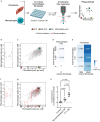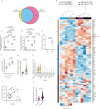The tumor microenvironment shows a hierarchy of cell-cell interactions dominated by fibroblasts
- PMID: 37726308
- PMCID: PMC10509226
- DOI: 10.1038/s41467-023-41518-w
The tumor microenvironment shows a hierarchy of cell-cell interactions dominated by fibroblasts
Abstract
The tumor microenvironment (TME) is comprised of non-malignant cells that interact with each other and with cancer cells, critically impacting cancer biology. The TME is complex, and understanding it requires simplifying approaches. Here we provide an experimental-mathematical approach to decompose the TME into small circuits of interacting cell types. We find, using female breast cancer single-cell-RNA-sequencing data, a hierarchical network of interactions, with cancer-associated fibroblasts (CAFs) at the top secreting factors primarily to tumor-associated macrophages (TAMs). This network is composed of repeating circuit motifs. We isolate the strongest two-cell circuit motif by culturing fibroblasts and macrophages in-vitro, and analyze their dynamics and transcriptomes. This isolated circuit recapitulates the hierarchy of in-vivo interactions, and enables testing the effect of ligand-receptor interactions on cell dynamics and function, as we demonstrate by identifying a mediator of CAF-TAM interactions - RARRES2, and its receptor CMKLR1. Thus, the complexity of the TME may be simplified by identifying small circuits, facilitating the development of strategies to modulate the TME.
© 2023. Springer Nature Limited.
Conflict of interest statement
The authors declare no competing interests.
Figures





References
Publication types
MeSH terms
Grants and funding
LinkOut - more resources
Full Text Sources
Molecular Biology Databases
Miscellaneous

